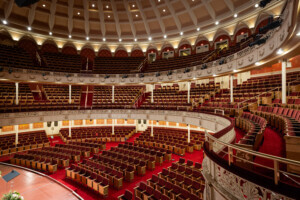One of Hideo Sasaki’s few remaining works in New York is set to be demolished as the Landmarks Preservation Commission (LPC) approved changes to the exterior of 601 Lexington Avenue, formerly known as the Citicorp Center.
The building, designed by Hugh A. Stubbins & Associates in 1973, features a stepped public plaza by Sasaki Associates. As it dips into 601 Lexington Avenue, the plaza, built in exchange for a taller tower, reveals a fountain and entrances to the subway.
Amid a dense urban setting, many consider the cascading design a welcome sight. Its corner location encourages passers-by to look up in tandem with steps towards the building’s open vertices made possible by Stubbins’s unusual column arrangement. Dubbed “super” columns, the four skyscraper supports rise above 100 feet and cover 24 square feet each. The resultant cantilevers articulate space in a way not commonly found in Manhattan and in the space, one is seldom aware of being situated below the 915-foot-tall structure, once described by critic Ada Louise Huxtable as a “singularly suave blockbuster that comes down to the street with innovative drama.”
This feature has prevailed for almost 40 years and subsequently, the sunken space works in an established harmony with the skyscraper. At the time of Stubbins’s death in 2006, critic Paul Goldberger called the Citicorp Center “probably the most important skyscraper built in New York in the 1970s because of its elegant and memorable shape, but also because of its engagement with the city at the base.”
Tuesday’s review included building entrances along 52nd and 53rd streets, as well as skylights and rooftop mechanical equipment. The Sasaki plaza, designed by principal emeritus Stuart Dawson, was included in the landmark designation, but DOB permits to alter the plaza were approved prior to the designation, and so the plaza changes were not under review by the LPC.
In a March 23 email, a LPC spokesperson clarified that the permits are unrelated to the designation report’s statement of regulatory intent (page 14) that states that the City Planning Commission is responsible for approving all changes to the plaza. The plaza design depicted in Gensler’s renderings was not being considered at the hearing that day, a situation infuriated some preservationists who came out to speak the meeting.
The renderings Gensler presented depicted the plaza without the fountain that was initially intended, in the words of the architect, to “mask much of the street noise and add to the feeling that the passerby is free from the congestion of the street.”
In a statement to The Architect’s Newspaper (AN) Dawson commented on the situation:
I was and am incredibly proud of the work we did on the sidewalks, plaza, cascading fountain, and interior atrium of the Citicorp Center. The response from the public was immediate and strong: they loved it. As the fate of this work is up in the air I cannot help but to return to the original idea that carried through all aspects of the project: the idea of connection. At the time, we asked why not carry the fountain and broad steps all the way from street level; to chapel and atrium entrance level; to the subway level? While it required difficult permitting and multiple bureaucratic maneuvers, it seemed well worth the effort—and it was. It was a first! And today, as I learn that the plaza we designed is in danger of demolition I ask that we consider connection once more. I would like to see the plaza live on, connecting one era of design into the next. Once again, it may take some persistent maneuvering but I believe it will once more be worth it.
Christabel Gough of the advocacy group Society for the Architecture of the City told AN that the Sasaki project has “fallen between the cracks of arcane inter-agency procedures and is not protected. Boston Properties would earn the gratitude of so many New Yorkers by abandoning the demolition plan revealed today.”
According to the LPC, the changes put forward by Gensler and Boston Properties were approved by the City Planning Commission prior to 601 Lexington Avenue’s designation as a landmark in December 2016 and that permits to alter the plaza had already been filed with the Department of Buildings (DOB). Despite an extensive search, at press time AN was unable to locate the permits on the DOB’s website.
At the hearing, preservationists and commissioners raised questions about the missing foundation.
“The HDC wishes to express its regret at reports that the water feature may be removed from the space, which seems like an unfortunate loss,” said Barbara Zay, of advocacy group the Historic Districts Council. “We would suggest that the LPC retain a seat at the table in discussions for the fate of courtyard by working closely with the owner, and perhaps the MTA, to find an alternative or return this decorative feature which provides an element of civility and whimsy to the space.”
Echoing Zay, Commissioner Michael Goldblum expressed regret about the turn of events. “It’s a shame that the plaza will be changed and the fountain lost,” he said, adding that the fountain was a “key element of how the public experience this complex.”
Fellow commissioner John Gustafsson clarified that no decision on the plaza could be made. “We’re not expressing an opinion here because we can’t,” he said. The only changes on the agenda then, were to that of the facade, particularly on 53rd Street. Here, a recessed entrance would be eradicated, but the LPC voiced weariness ahead of this decision.
AN asked representatives from Gensler and Boston Properties at the hearing about why they are eliminating the plaza. Both declined to comment.
In her closing statement, chair Meenakshi Srinivasan noted that “the Citicorp Building has a long history of changes… We recognized that these spaces will continue to change.” She concluded that the proposed modifications were consistent with the building’s history, and retained the spirit of the original design intent, particularly with the building’s zoning history in mind.
Prior to granting its approval, the LPC suggested that the proposed changes to the recessed entranceway be reconsidered. But questions remain as to why a plaza so integral to the landmark is beyond the LPC’s oversight in the first place. AN will keep readers updated on this story as it develops.
Update 3/22/17: This article originally stated that Sasaki’s plaza was not included in the building’s December 2016 landmark designation. It was in fact included in the designation. The post was also updated to include clarifying information about the plaza’s jurisdiction and additional background on the statement of regulatory intent. The text was updated to reflect that Sasaki Associates principal emeritus Stuart Dawson designed the fountain.










